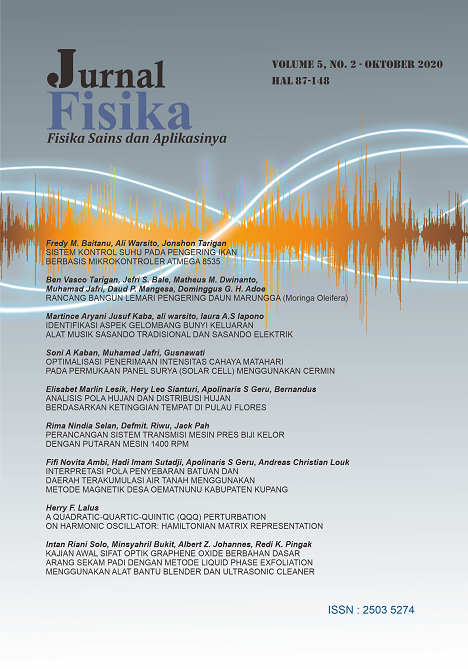IDENTIFIKASI ASPEK GELOMBANG BUNYI KELUARAN ALAT MUSIK SASANDO TRADISIONAL DAN SASANDO ELEKTRIK
Abstract
ABSTRAK
Telah dilakukan penelitian tentang identifikasi aspek gelombang bunyi alat musik sasando tradisional dan sasando elektrik. Subjek penelitian ini adalah bunyi alat musik sasando tradisional dan sasando elektrik yang bertipe sasando biola dengan jumlah dawai 32. Bunyi alat musik sasando direkam dengan mikrofon Havit Straight M-80 dan dianalisis menggunakan perangkat lunak Wavepad sound editor. Aspek gelombang bunyi ditentukan dengan menggunakan metode Fast Fourier Transform (FFT). Sampel original bunyi sasando tradisional dan sasando elektrik dengan rentang frekuensi dari 86 Hz sampai 1206 Hz dan 97 Hz sampai 1077 Hz. Rentang intensitas dari sasando tradisional dan sasando elektrik secara berturut-turut (-45,95398906) dB sampai (-12,38564365) dB dan (-33,44661942) dB sampai (-9,780729931) dB. Kemudian dengan perangkat lunak excel diperoleh grafik data bunyi sasando tradisional dan sasando elektrik berupa grafik intensitas, frekuensi dan noise. Setelah dilakukan filter terhadap sampel original bunyi sasando tradisional dan sasando elektrik, yang mempengaruhi kualitas gelombang bunyi adalah adalah rentang noise pada sampel bunyi dari pengolahan data -2 dB sampai 0 dB dan -4,22 dB sampai -0,14 dB dengan persentase noise 0 % sampai 8,27 % dan 0,57 % sampai 22,76 %. Sebagian besar persentasi noise berpengaruh pada bunyi asli.
Kata Kunci: Sasando, sampel original, mikrofon Havit Straight M-80, Wavepad sound editor, metode Fast Fourier Transform (FFT), frekuensi, intensitas, noise.
ABSTRACT
Research has been conducted on the identification of aspects of the sound waves of traditional Sasando musical instruments and Sasando electric. The subject of this research is the sound of traditional Sasando musical instruments and Sasando electric type of Sasando violin with 32 strings. The sounds of Sasando musical instruments were recorded with the Havit Straight M-80 microphone and analyzed using Wavepad sound editor software. Sound wave aspects are determined using the Fast Fourier Transform (FFT) method. Original samples of traditional Sasando sound and Sasando electric range in frequency from 86 Hz to 1206 Hz and 97 Hz to 1077 Hz. The intensity ranges from traditional Sasando and Sasando electric are (-45,95398906) dB to (-12,38564365) dB and (-33,44661942) dB to (-9,780729931) dB. Then with Excel software obtained data graphs of traditional Sasando sound and Sasando electric in the form of graphs of intensity, frequency and noise. After filtering the original samples of traditional Sasando sound and Sasando electric, what affects the sound wave quality is the range of noise in the sound sample from data processing of -2 dB to 0 dB and -4.22 dB to -0.14 dB with a percentage of noise 0 % to 8.27% and 0.57% to 22.76%. Most of the noise percentage affects the original sound.
Keywords: Sasando, original sample, Havit Straight M-80 microphone, Wavepad sound editor, Fast Fourier Transform (FFT) method, frequency, intensity, noise.
Downloads
Copyright (c) 2020 Jurnal Fisika : Fisika Sains dan Aplikasinya

This work is licensed under a Creative Commons Attribution-NonCommercial-ShareAlike 4.0 International License.
Jl. Adisucipto, Penfui-Kupang, Lasiana, Klp. Lima, Kota Kupang, Nusa Tenggara Timur., Indonesia
This work is licensed under Attribution-NonCommercial-ShareAlike 4.0 International (CC BY-NC-SA 4.0)
 Martince Aryani Jusuf Kaba(1)
Martince Aryani Jusuf Kaba(1)

















